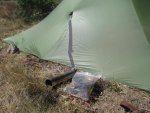Beendare
WKR
- Joined
- May 6, 2014
- Location
- Corripe cervisiam
So what is your opinion on the tent fabrics out there in regards to their properties?
For example, i know there is some issues with stretch/shrinkage. i used the 1.6oz hyper d from RBTR and did a 12 sided tipi to mitigate stretch [more seams for tensioning] I get a little shrinkage [gets loose] going from heated to cold..but after retightening it ALMOST goes away completely...but not totally. BTW, a guy can really crank down on this fabric and get it drum tight.
Is there one of these fabrics that holds the tension hot and cold? I've only used sil nylon for tarps...no tents.
Sil nylon....sil poly....which do you prefer for what application?
For example, i know there is some issues with stretch/shrinkage. i used the 1.6oz hyper d from RBTR and did a 12 sided tipi to mitigate stretch [more seams for tensioning] I get a little shrinkage [gets loose] going from heated to cold..but after retightening it ALMOST goes away completely...but not totally. BTW, a guy can really crank down on this fabric and get it drum tight.
Is there one of these fabrics that holds the tension hot and cold? I've only used sil nylon for tarps...no tents.
Sil nylon....sil poly....which do you prefer for what application?



